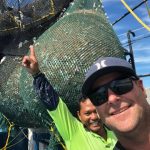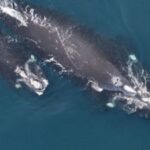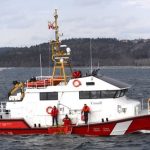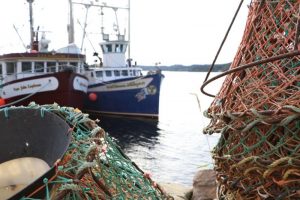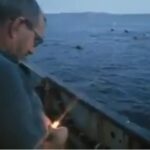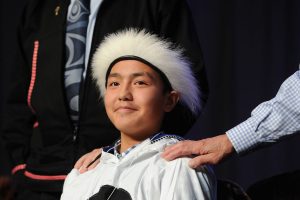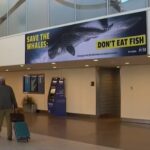Tag Archives: National Marine Fisheries Service

Lobstermen threatened with the extinction of their way of life
The word “extinction” has been thrown around a lot lately by environmental groups,,, Large, well-funded, out-of-state environmental groups would have you believe that these whales are going extinct and that Maine fishing gear entanglement is a major reason why. These groups have proposed things like ropeless fishing and refuse to believe that ideas like this are not practical in Maine. Can you imagine how a fisherman could set his 20- to 30-trap trawl into water 300 to 400 feet deep, not knowing where any of his competitors’ trawls might have been set days before? >click to read< 11:37

About 70 frustrated fishermen tell feds at a hearing in Machias that Canada, not Maine, is mostly to blame.
About 70 fishermen came to the first fisheries service public meeting in Maine on the latest round of lobster rule changes being considered to protect the endangered whales. They expressed safety fears and their mounting frustration. The state’s $485 million-a-year lobster industry is facing a federal mandate to lower the number of buoy lines in the Gulf of Maine by 50 percent to protect right whales.,,, >click to read< 12:09
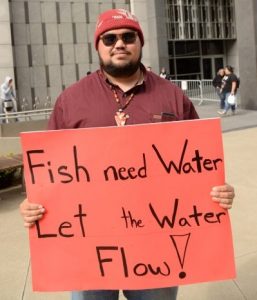
Yurok Tribe and Commercial Fishing Group, PCFFA, File Suit to Save Klamath Salmon
This afternoon, the Yurok Tribe and the Pacific Coast Federation of Fishermen’s Associations (PCFFA) filed a lawsuit against the Bureau of Reclamation and the National Marine Fisheries Service in response to low flows and high salmon disease rates under the federal agency’s new management plan for the Klamath River. The groups are represented by the environmental law firm Earthjustice. >click to read< 08:39
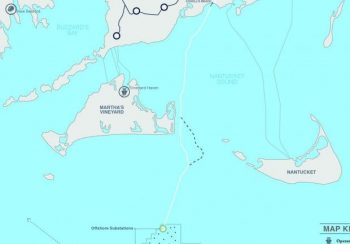
Fishermen Are At Heart of Delay in Vineyard Wind Project
The fishermen’s breakthrough with the National Marine Fisheries Service mirrors their breakthrough last month with the Edgartown Conservation Commission, which voted 5-1 on June 27 to reject a permit for Vineyard Wind to lay cable on the ocean floor about a mile east of Martha’s Vineyard’s eastern shore. That meeting was not audiotaped or videotaped, according to a town official, but reports say that fishermen raised concerns that electromagnetic radiation from the cable may disrupt the ability of fish to communicate with each other, and therefore decrease the number of fish. Fishermen were also concerned the laying of the cable could itself damage the fishery. >click to read<12:08
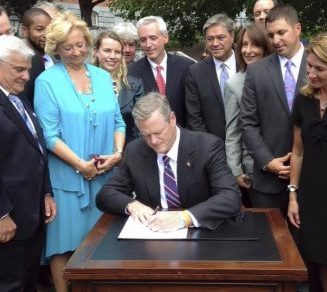
Governor Charlie Baker eyeing ‘cure plan’ for Vineyard Wind project
After a “really productive and substantive” meeting with new U.S. Interior Secretary David Bernhardt in Washington, D.C., on Monday morning, Gov. Charlie Baker said his administration will be working with Vineyard Wind,,, On Monday, Reuters reported that the National Marine Fisheries Service “triggered the delays by declining to sign off on the project’s design, as proposed by the Bureau of Ocean Energy Management” and that a regional director for the agency “said his agency could not support the environmental permit for Vineyard Wind because the project failed to fully address the concerns of the fishing industry.”,,, Pressed by a reporter as to why he would not say fishing was among the concerns, Baker responded: “Can you read the comments? They’re not that hard to find. Certainly, there were issues that were raised by fishing. There were issues that were raised by a number of other federal agencies as well.” >click to read< 19:44
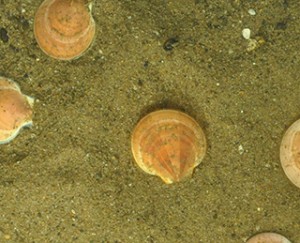
The 2020-2021 Scallop RSA Competition is underway; the Project Proposal Deadline is September 20th!
The federal competition for 2020-2021 awards through the Scallop Research Set-Aside (RSA) Program is now open. The deadline for submitting full proposals is Friday, September 20, 2019 at 5 p.m. The New England Fishery Management Council established the Scallop RSA Program under the Atlantic Sea Scallop Fishery Management Plan. The Council sets research priorities for this program, while the National Marine Fisheries Service (NMFS/NOAA Fisheries) administers the RSA competition, oversees award projects, and monitors set-aside harvest activities through the Northeast Fisheries Science Center and Greater Atlantic Regional Fisheries Office (GARFO). >click to read< 16:27
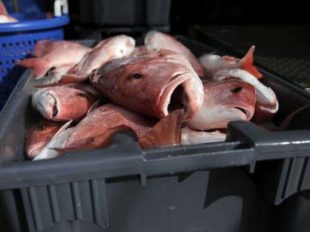
Cape Coral fishing captain admits illegal grouper, snapper hauls, federal prosecutors say
A Cape Coral fishing boat captain faces possible federal prison time after admitting in federal court Monday that he illegally caught and sold 50,000 pounds of red grouper and red snapper over five years, in defiance of Gulf of Mexico limits. Federal prosecutors said Mark Zywotko lied about the size of his boat’s haul of the grouper and snapper in reports fishing boats must file reporting catches of some popular and protected gulf reef fish. >click to read< 12:40
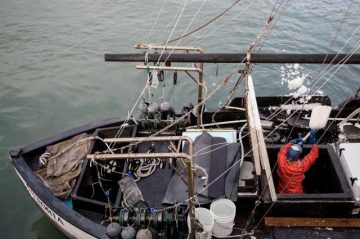
California fishermen report the biggest salmon season in a decade
California commercial fishermen are reporting the biggest king salmon season in a decade, on the heels of three years of disastrously low catches because of the drought. The sudden bounty has resulted in a price drop for the coral-pink, fatty fillets to $20 per pound in many markets, down from the $30- to $35-per-pound range of recent years. “You might say this is the old normal, because we’ve been so used to catastrophe,” said Noah Oppenheim, >click to read<19:37
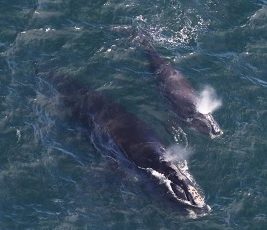
Our View: Lobster gear changes not yet warranted
A plan to drastically reduce the amount of fishing line in the waters off Maine has lobstermen up and down the coast worried about their future. It is pitting small inshore operators against those who haul in deeper waters. And there’s little evidence it will work. The plan is part of an effort by federal regulators to save the North Atlantic right whale,,,, The National Marine Fisheries Service estimates that fishing rope kills or seriously injures five to nine right whales a year,,, But none of the deaths has been tied conclusively to Maine lobster gear. >click to read<09:20
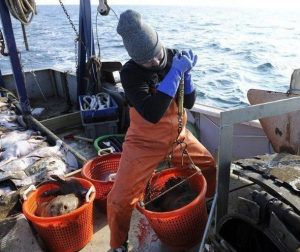
Groundfishermen not hooked by monitoring alternatives
For more than two years, the New England Fishery Management Council has worked on an intricate groundfish monitoring amendment that could have wide-scale economic and regulatory consequences for groundfishermen. It has been a thorny, winding path that involves a host of groundfish committees, plan development teams and assorted staff within the far-flung fisheries regulatory landscape. Now a group of groundfishermen are weighing in. And they are not pleased. >click to read<07:53
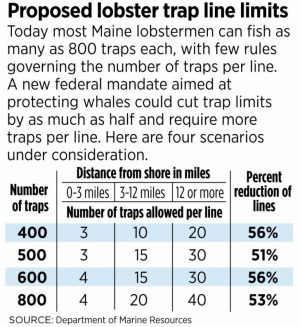
New rules are meant to save whales; lobstermen wonder if they’ll survive
The state Department of Marine Resources has until September to come up with a way that it can cut the number of buoy lines in the Gulf of Maine by 50 percent. Federal regulators say that’s what it will take to reduce the risk of fatal entanglement enough for the species to survive. Scientists estimate only 411 right whales remain. The species has been on the brink of extinction before, most recently in 1992, when its population bottomed out at 295. It rebounded to about 500 in 2010, but low calving rates, ship strikes and fishing line entanglements have sent its numbers tumbling, yet again. But many in Maine’s $485 million industry worry it is the lobsterman who will face extinction,,, >click to read<10:28

Maine lobster fishery agrees to deep cuts to protect whales
After a long and difficult week in late April in which the National Oceanographic and Atmospheric Administration’s Marine Mammal Take Reduction Team met to address protections for the endangered right whale, the Maine lobster fishery now has a sense of what the future holds. There were some hard battles along the way, in which we lobster industry advocates fought to ensure a viable Maine fishery, both for today’s lobstermen and for future generations. By Patrice McCarron >click to read<14:39
Competing interests – “The farmer and the cowman should be friends,” according to Richard Rodgers’ lyrics in “Oklahoma!” Can a similar peace pact be visited upon Maine’s lobstermen and the advocates of whale safety? >click to read<
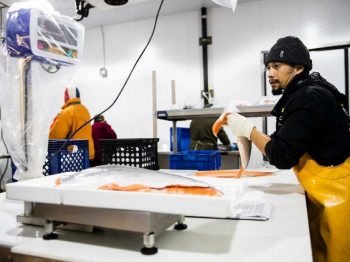
King salmon arrives in stores, commanding royal prices; relief could come soon
King salmon, once as ubiquitous as burgers in backyard Bay Area barbecues, has commanded astonishingly high prices in recent years,,, Since the 2019 season opened on May 1, supply has been very limited, so prices have remained steep, reaching as high as $40 a pound in San Francisco.,,, That should start to change on Thursday, when 200 more miles of coast will open to commercial salmon fishing,… there will likely be more salmon on the market this summer is because some crab boats are planning to go out for salmon fishing, because the Dungeness crab fishery closed several months early as part of a settlement,,, >click to read<21:54

Halving the number of vertical lines – Finding consensus on whale protections a tough call in Maine
Federal regulators have given Maine’s lobster industry its marching orders: Find a way to cut the number of surface-to-seabed fishing lines by 50 percent to help prevent the injury or death of even one of the endangered right whales that pass through the Gulf of Maine. The National Marine Fisheries Service is allowing each lobstering state to develop its own plan to protect the whale, whose numbers have fallen to a little more than 400 in recent years. But it will be hard to find one way to make it work in Maine, where the $485 million-a-year fishery is known for its diversity. >click to read<07:29
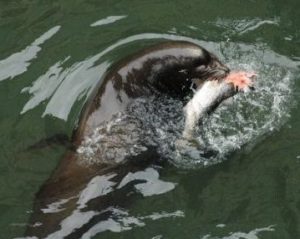
Salmon-eating sea lions targeted at Columbia River dam
More California sea lions preying on imperiled salmon in the Columbia River below a hydroelectric project on the Oregon-Washington border are being killed under a revised policy, federal authorities said Friday. The National Marine Fisheries Service made public reduced criteria for removing sea lions at Bonneville Dam about 145 miles (235 kilometers) from the Pacific Ocean. The new guidelines that went into effect April 17 permit any California sea lion seen in the area on five occasions or seen eating a fish to be put on a list for lethal removal. >click to read<10:57
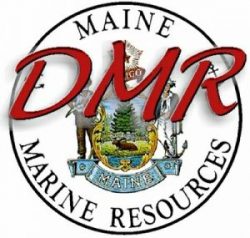
Notice from Commissioner Keliher: Update on Federal Whale Rules
As many of you know, the National Marine Fisheries Service’s Atlantic Large Whale Take Reduction Team (TRT) met last week and recommended broad measures that included a target to remove 50 percent of endlines from the Gulf of Maine. The remaining endlines will also need to be made safer so that, if a whale does come in contact with a line, the rope will break. The outcome for Maine’s lobster industry could have been far worse. Many TRT participants did push for a phase-in of ropeless fishing over five or ten years, large scale closed areas (including two in Maine), and weak rope across the entire fishery. In the end, Maine delegates were successful in pushing back on those proposals,,, Click to read<10:12

‘Neither country can save the species on its own’ – Reduce amount of rope in water to protect right whales, says U.S. advisory group
The National Oceanic and Atmospheric Administration (NOAA) Atlantic Large Whale Take Reduction Team held four days of meetings ending Friday.
The group proposes the number of lines in the water be reduced by up to 50 per cent in some jurisdictions and that the breaking strength of buoy lines be reduced to 1,700 pounds (771 kilograms) or less. Now the onus is on the U.S. National Marine Fisheries Service to consider acting on those recommendations. While researchers from both countries agree that there needs to be less rope in the water, the recommendations are a different approach to that of the Canadian government, which imposed fisheries closures in the Gulf of St. Lawrence last year and again in 2019. >click to read<09:20
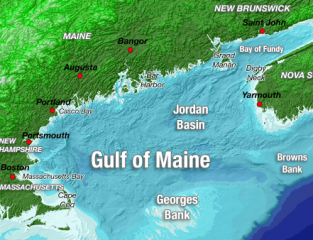
CLF OVERRULED! New Fishing Rights in Gulf of Maine Upheld by Judge
A federal judge upheld a rule Monday that opens up a portion of the western Gulf of Maine to commercial and recreational fishing for the first time. The Conservation Law Foundation had challenged the rule last year, claiming the National Marine Fisheries Service wrongly prioritized economic considerations over its conservation duty when it reduced the protected area in that portion of the Gulf by about 25%. While the rule offered habitat protection in the eastern Gulf of Maine for the first time, the conservation group said the agency and the New England Regional Council should have closed more of the Gulf to fishing. >click to read<17:28
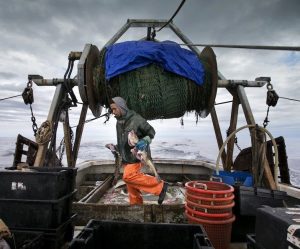
DC Circuit Sinks Challenge to Fishing Bycatch Rule
The D.C. Circuit on Friday upheld the government’s method of counting fish and other sea life that are unintentionally swept up in commercial fishing nets. The NMFS changed its method for counting bycatch in 2015,,, The 2015 change puts trained reporters, typically biologists, on a sample of fishing boats to count bycatch. Their numbers are then extrapolated across entire fleets, giving the government an estimate to work with. Conservation group Oceana challenged the new rule,,, >click to read<19:25
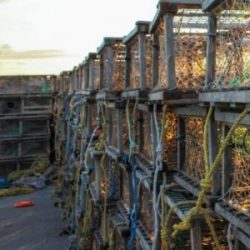
UNACCEPTABLE – Strict right whale protection goal raises concerns among lobstermen
Patrick Keliher, head of the Maine Department of Marine Resources, announced the proposed target at a conference of U.S. and Canadian lobstermen in Portland Friday while defending a decision to cancel three meetings with Maine fishermen to talk about looming right whale protections.,,, The National Marine Fisheries Service estimates that fishing rope entanglement kills or seriously injures five to nine right whales a year,… A few minutes later, Keliher got an email from the fisheries service that spelled out its risk reduction target. Frustrated, he stood up and delivered apparent bad news – he told an already exasperated audience that the service now wanted a 60 percent to 80 percent reduction in the size of the lobster fishery. The room erupted with anger. >click to read<22:49
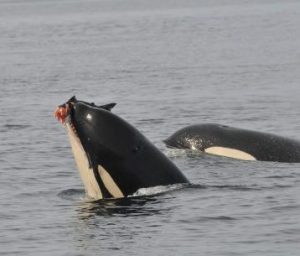
Environmental groups sue to restrict salmon fishing for Northwest orcas
The Center for Biological Diversity, which filed a lawsuit nearly two decades ago to force the U.S. government to list the orcas as endangered, and the Wild Fish Conservancy asked the U.S. District Court in Seattle on Wednesday to order officials to reconsider a 2009 finding that commercial and recreational fisheries did not jeopardize the orcas’ survival. >Video, click to read<10:09
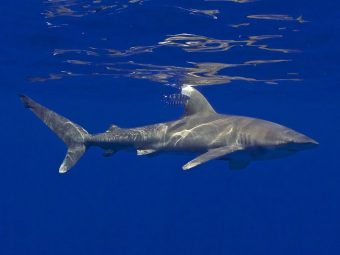
Con Groups File Intent to Sue to Protect Atlantic Sharks, Giant Rays From Lethal Longlines, Gillnets
On behalf of the Center for Biological Diversity and Defenders of Wildlife, Earthjustice today filed a notice of intent to sue the Trump administration for failing to protect oceanic whitetip sharks and giant manta rays from being killed by longlines and huge nets used by U.S. fishermen in Atlantic fisheries. >click to read<13:59
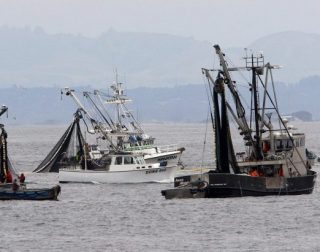
Sardine fishery likely will be closed this season
Sardine fishermen in Monterey Bay are facing a fifth straight year of restrictions on the amount they will be permitted to catch, creating financial hardships for the commercial industry.,,, Diane Pleschner-Steele, executive director of the California Wetfish Producers Association, was not available to comment Wednesday, but she told the Monterey Herald following the 2018 assessment that “fishermen are seeing more sardines, not less, especially in nearshore waters.” She believes the methods in which the Marine Fisheries collect data is flawed. Not only does Pleschner-Steele reject the notion that overfishing played a role in the decline of the sardine stock, she calls the stock’s collapse “fake news.” >click to read<20:16

Whales are facing a deadly threat along West Coast: container ships
One day last May, a container ship entered the San Francisco Bay with extra cargo. A 45-foot-long dead female fin whale was draped across the ship’s bow. The impact with the ship had broken her back, ruptured her organs and caused severe internal bleeding. Ten whale deaths were attributed to ship strikes in 2018 – the highest number on record in California since NOAA Fisheries began tracking in 1982. The mortality rate represents an enormous increase from the average 3.4 ship strike victims recorded annually in the five previous years. Five of the 10 whales that died with boat collision injuries in 2018 were endangered or threatened fin, blue and humpback whales. >click to read<15:29

Impending whale protections worry fishermen
With the majority of American lobsters caught in Maine, the state’s lobster fishermen could bear the brunt of changes in federal fishery regulations to save the endangered right whale. At the March 1 Fisherman’s Forum update on the threat of extinction for the North Atlantic right whale, it became clear regulators believe changes to fishing gear will be announced sometime this year. Right whale presentation – National Oceanic and Atmospheric Administration official Mike Asaro explained that most of the remaining 450 North Atlantic right whales are male, with a population of about 100 females,,,. >click to read<16:17
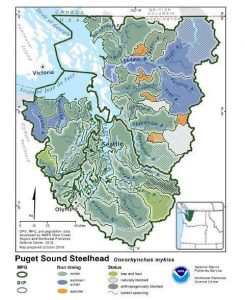
Feds release Puget Sound steelhead recovery plan
The National Marine Fisheries Service has drafted a recovery plan for Puget Sound steelhead, including those from the Skagit River. The fisheries service, which is a division of the National Oceanic and Atmospheric Administration, is taking public comment on the plan through March 28. A recovery plan is required for any species protected under the U.S. Endangered Species Act. >click to read<10:53
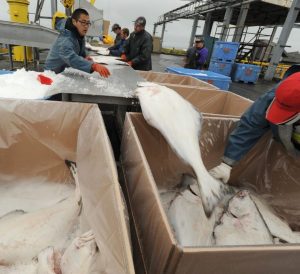
Complaints about ‘chalky’ halibut draw attention from international commission
After years of hearing concerns from fishermen about the prevalence of “chalky” Pacific halibut, the International Pacific Halibut Commission is planning to gather information for an investigation into it. Chalky halibut are fish that, when cut open, have a stiff, chalk-textured flesh as opposed to the normal pale and tender flesh. Chalky meat is not dangerous to humans but is not desirable and thus costs the fishermen at the dock. Dr. Josep Planas, who heads up biological research for the IPHC, noted plans to gather information about chalky halibut from stakeholders,, >click to read<16:07
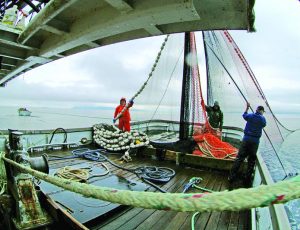
Southeast purse seiners to hold another permit buyback vote
Southeast Alaska purse seine fishermen are preparing to vote on another permit buyback, with an eye toward making the fishery more viable in an era of more efficient vessels and smaller salmon runs. The National Marine Fisheries Service is scheduled to send out ballots to fishermen starting Jan. 15 asking whether the fleet should take on $10.1 million in federal loans to buy out 36 permits, removing them from the fishery forever. If successful, the move would reduce the number of permits in the fishery to 279, down about 100 permits since 2012. >click to read<14:35
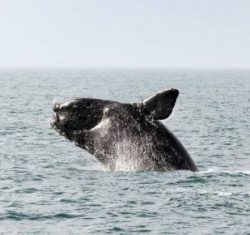
Whale rule changes coming on two tracks
Maine lobstermen and their representatives, along with state fisheries regulators, continue in the trenches of debates about how much the Maine lobster fishery is implicated in the decline of the North Atlantic right whale. Ongoing efforts to protect the whales from entanglement with fishing gear may result in two different new sets of regulations, Sarah Cotnoir, resource coordinator for the Maine Department of Marine Resources, and Patrice McCarron, executive director of the Maine Lobstermen’s Association, told the Zone B Council last week. >click to read<11:03
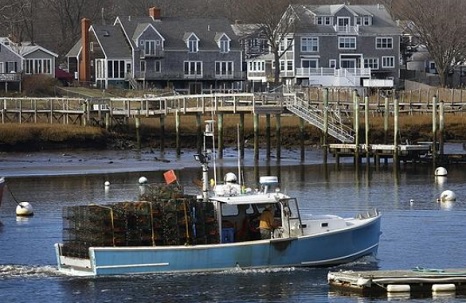
North Atlantic Right Whale: Fishing closure looms over South Shore lobstermen
The annual fishing closure that forces a halt of the lobstering industry each winter is still a month away, but lobstermen are already pulling their traps out of the water and preparing for a long three months of trying to make ends meet. For the last four years, federal regulations have forced lobstermen out of the water from Feb. 1 to April 30, an attempt to lessen the number of North Atlantic right whales that die due to fishing gear entanglements. Not only can the fishermen not be in the water, but they also have to pull all of their traps from the ocean floor before Feb. 1 — as many as 800 per commercial license. >click to read<19:15


































